Yukhari Govhar Agha Mosque
| Yukhari Govhar Agha Mosque | |
|---|---|
Azerbaijani: Yuxarı Gövhər Ağa Məscidi | |
 The restored mosque in 2024 | |
| Religion | |
| Affiliation | Shia Islam |
| Ecclesiastical or organizational status | 1885–1923: Mosque 1923–1988: Museum 1988–1992: Mosque 1992–2019: Damaged, abandoned 2019–2020: Museum 2020–present: Mosque |
| Location | |
| Location | Shusha |
| Country | Azerbaijan |
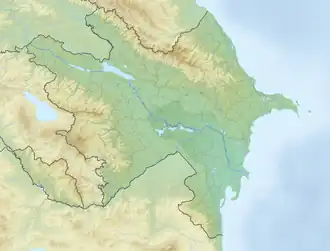 Location of the mosque in Azerbaijan | |
| Geographic coordinates | 39°45′36″N 46°45′09″E / 39.7600°N 46.7526°E |
| Architecture | |
| Architect(s) | Karbalayi Safikhan Karabakhi |
| Type | Mosque architecture |
| Style | Islamic |
| Founder | Ibrahim Khalil Khan |
| Groundbreaking | 1182 AH (1768/1769CE) |
| Completed | 1885 |
| Minaret(s) | 2 |
The Yukhari Govhar Agha Mosque (Azerbaijani: Yuxarı Gövhər Ağa Məscidi), also called the Great Juma Mosque of Govhar Agha (Azerbaijani: Böyük Gövhər Ağanın Cümə Məscidi), is an Azerbaijani Shia Muslim mosque located in the city of Shusha, Azerbaijan.[1]
It was firstly built in 1768 under the orders Ibrahim Khalil Khan, on the site of an old reed mosque, but finished by Karbalayi Safikhan Karabakhi on the orders of Govhar Agha, the daughter of Ibrahim Khalil Khan, in 1885.
Former Artsakh authorities and media outlets have falsely claimed several times that the mosque is "Persian" or "Iranian heritage".[2][3][4]
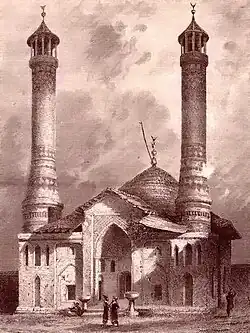
History

Yuxarı Gövhər Ağa Məscidi means Upper Govhar Agha Mosque in Azerbaijani, referring to the location of the mosque in the upper section of Shusha and to distinguish it from the Ashaghi Govhar Agha Mosque, the same-name mosque located in the lower section of the town. Both mosques are considered symbols of Shusha and masterpieces of Eastern architecture.[5][6] It is named after the daughter of Ibrahim Khalil Khan, Govhar Agha, who ordered the construction of the mosque to be finished. The Yukhari Govhar Agha Mosque is located on Shusha's main square, Yusif Vazir Chamanzaminli street and makes up a big part of the architectural complex including madrasa, shops, and houses built by the same architect.[1][7] According to historian and author of "Karabakh-name", Mirza Jamal Karabakhi, construction of the mosque was started with orders of Ibrahim Khalil Khan in 1182 AH (1768/1769CE), but was stopped for a long time. The construction was then restarted and completed in 1883–1885 by architect Karbalayi Safikhan Karabakhi ordered by Govhar Agha.[8]
.jpg)
.jpg)
The exterior and interior

The prayer hall of Yukhari Govhar Agha Mosque is a three-nave in a square shape, 190 m × 185 m (623 ft × 607 ft), split by six stone columns. The three-beam veranda in the northern section of the mosque gives it a rectangular form,
26.5 m × 21.5 m (87 ft × 71 ft). The mosque has two minarets. The balconies used to host women's premises of the prayer hall. The interior of the prayer hall gets light from dual windows. The two minarets on the facade make up the veranda. The building of the mosque was constructed out of stone, while the two minarets are made of bricks. The minarets have cylindric forms with horizontal belts, with each section laid in distinguishing brick patterns. The same construction pattern can be viewed in most of the mosques throughout Karabakh built by Kerbalayi Safikhan Karabakhi.[1] In Soviet times, the mosque was closed and used as a museum, but reopened as a functioning mosque in 1988.
Armenian occupation
After the capture of Shusha by ethnic Armenian forces during the First Nagorno Karabakh War, the mosque was largely abandoned and descecrated until some minor restoration work in 2008 to fix the roof.[9][10] Official reports from 2003 said that the mosque was being used as a storehouse and depot and later satellite imagery showed that the mosque was among many other Azerbaijani mosques in Nagorno-Karabakh that were damaged.[11][12] Afterwards, local Artsakh officials ordered a restoration project with Iranian help,[13] however they were met with criticism by Azerbaijani officials, with fear of Armenia "covering up vandalism".[14] The restoration eventually ended in 2019, with the mosque itself, the madrasa and the park nearby officially being opened for tourism, however not as a functioning mosque but a museum. It was also missing its old red roof.[15] It was finished with contributions from Russian-Armenian businessman Ruben Vardanyan and Kazakh businessman Kairat Boranbayev.[16][17] Armenian officials however falsely claimed that it was an "Iranian mosque", turning it into an Armenian-Iranian Cultural Center and having no mention of the Azerbaijani heritage.[4][2][3]
Azerbaijani control
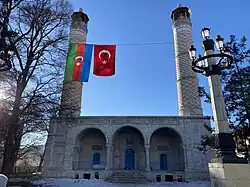
After Azerbaijan brought Shusha back under its control in the Second Nagorno-Karabakh War, it started a restoration of the mosque, funded with the support of the Heydar Aliyev Foundation, which took place from 2021 to 2023. The mosque and nearby madrasa were completely renovated, adding back carpets, the red roof and making it a functioning mosque again.[18][19]
The first Friday prayer was held in the mosque, after 28 years, on 13 November 2020 by Azerbaijan soldiers.[20][21]
Gallery
-
 Mosque in May 2023
Mosque in May 2023 -
 Madrasa of the mosque in May 2023
Madrasa of the mosque in May 2023 -
 Museum inside the mosque
Museum inside the mosque -
 The mosque in 2010, with damaged minarets
The mosque in 2010, with damaged minarets -
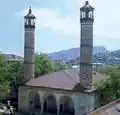 The mosque before 1992 capture
The mosque before 1992 capture -
 One of the restored minarets
One of the restored minarets -
 South-west view of the mosque after restoration in 2019, missing the red roof
South-west view of the mosque after restoration in 2019, missing the red roof -
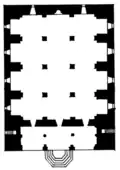 The architectural plan of the mosque
The architectural plan of the mosque -
 Mosque on the stamp of Azerbaijan
Mosque on the stamp of Azerbaijan -
 Graves in the mosque's courtyard
Graves in the mosque's courtyard
See also
References
- ^ a b c "Shusha State Historical & Architectural Reserve". Archived from the original on 4 October 2010. Retrieved 20 July 2010.
- ^ a b MassisPost (14 April 2017). "Restoration Works of Mosque in Shushi Are in Line With Provisions of International Conventions • MassisPost". MassisPost. Retrieved 3 August 2025.
- ^ a b "One of the historical testimonies of the Armenian-Iranian cultural dialog - m." orbeli.am. Retrieved 3 August 2025.
- ^ a b "Karabakh's contentious mosque restoration". Eurasianet. Retrieved 12 May 2020.
- ^ "PACE – Urgency to prevent the destruction of cultural monuments in the Armenian-occupied town of Shusha of Azerbaijan". Retrieved 20 July 2010.
- ^ "Чудеса Азербайджана" (in Russian). Archived from the original on 20 November 2021. Retrieved 26 July 2010.
- ^ "Наши культурные ценности – Шушинский район". Archived from the original on 23 October 2010. Retrieved 26 July 2010.
- ^ Avalov, Elturan (1977). Архитектура города Шуши и проблемы сохранения его исторического облика (in Russian). Baku: Elm. p. 54.
- ^ "Excavation works start in the Iranian Upper Mosque of Shushi". Panorama.am. Helix Consulting LLC. 31 March 2017. Retrieved 14 September 2022.
- ^ "Human Rights group". Archived from the original on 26 July 2011. Retrieved 23 July 2010.
- ^ Aggression against Azerbaijan is the Appeal to the World Community (PDF)
- ^ Mammadli, Nargiz. "Satellite Images Reveal New Details About Armenia's Destruction Of Azerbaijan's Heritage".
- ^ "Karabakh readies restoration project for Persian mosque".
- ^ "Azerbaijan reacts to Iranian company restoring mosque in Shusha". Archived from the original on 3 August 2017. Retrieved 2 August 2017.
- ^ "Gohar Agha Upper Mosque restored, inaugurated as Armenian-Iranian Cultural Center in Artsakh". armenpress.am. Retrieved 12 May 2020.
- ^ "Верхняя мечеть Шуши обрела вторую жизнь" [The Yukhari Govhar Agha Mosque Is Revived] (in Russian). Golos Armenii. 15 October 2019.
- ^ Жуков, Иван (31 January 2018). "Кайрат Боранбаев жертвует средства на восстановление мечети в Нагорном Карабахе". forbes.kz (in Russian). Retrieved 12 May 2020.
- ^ "Şuşada Yuxarı Gövhər Ağa məscidi əsaslı yenidənqurma və bərpadan sonra açılıb". baku.ws (in Azerbaijani). Retrieved 3 August 2025.
- ^ "Yukhary Govhar Agha Mosque". Projects: Culture. Heydar Aliyev Foundation. 2024. Retrieved 23 December 2024.
- ^ "İyirmi səkkiz ildən sonra Şuşada cümə namazı qılındı". azerbaijan-news.az. 13 November 2020. Archived from the original on 20 November 2021. Retrieved 14 November 2020.
- ^ "Karabakh: Shusha hears Friday prayer call after decades". 18 November 2020.